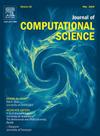Spline tie-decay temporal networks
IF 3.7
3区 计算机科学
Q2 COMPUTER SCIENCE, INTERDISCIPLINARY APPLICATIONS
引用次数: 0
Abstract
Increasing amounts of data are available on temporal, or time-varying, networks. There have been various representations of temporal network data each of which has different advantages for downstream tasks such as mathematical analysis, visualizations, agent-based and other dynamical simulations on the temporal network, and discovery of useful structure. The tie-decay network is a representation of temporal networks whose advantages include the capability of generating continuous-time networks from discrete time-stamped contact event data with mathematical tractability and a low computational cost. However, the current framework of tie-decay networks is limited in terms of how each discrete contact event can affect the time-dependent tie strength (which we call the kernel). Here we extend the tie-decay network model in terms of the kernel. Specifically, we use a cubic spline function for modeling short-term behavior of the kernel and an exponential decay function for long-term behavior, and graft them together. This spline version of tie-decay network enables delayed and -continuous interaction rates between two nodes while it only marginally increases the computational and memory burden relative to the conventional tie-decay network. We show mathematical properties of the spline tie-decay network and numerically showcase it with three tasks: network embedding, a deterministic opinion dynamics model, and a stochastic epidemic spreading model.
样条捆绑衰减时间网络
在时间或时变网络上可用的数据越来越多。时间网络数据已经有了各种各样的表示,每种表示对于下游任务都有不同的优势,例如数学分析、可视化、基于代理的时间网络和其他动态模拟,以及发现有用的结构。连接衰减网络是时间网络的一种表现形式,其优点包括从离散的时间戳接触事件数据生成连续时间网络的能力,具有数学可追溯性和低计算成本。然而,就每个离散接触事件如何影响随时间变化的连接强度(我们称之为核)而言,当前的连接衰减网络框架是有限的。在这里,我们根据核扩展了捆绑衰减网络模型。具体来说,我们使用三次样条函数来模拟核的短期行为,使用指数衰减函数来模拟核的长期行为,并将它们嫁接在一起。这种样条版本的连接衰减网络实现了两个节点之间延迟和c1连续的交互速率,而相对于传统的连接衰减网络,它只略微增加了计算和内存负担。我们展示了样条捆绑衰减网络的数学性质,并通过三个任务对其进行了数值展示:网络嵌入、确定性意见动态模型和随机流行病传播模型。
本文章由计算机程序翻译,如有差异,请以英文原文为准。
求助全文
约1分钟内获得全文
求助全文
来源期刊

Journal of Computational Science
COMPUTER SCIENCE, INTERDISCIPLINARY APPLICATIONS-COMPUTER SCIENCE, THEORY & METHODS
CiteScore
5.50
自引率
3.00%
发文量
227
审稿时长
41 days
期刊介绍:
Computational Science is a rapidly growing multi- and interdisciplinary field that uses advanced computing and data analysis to understand and solve complex problems. It has reached a level of predictive capability that now firmly complements the traditional pillars of experimentation and theory.
The recent advances in experimental techniques such as detectors, on-line sensor networks and high-resolution imaging techniques, have opened up new windows into physical and biological processes at many levels of detail. The resulting data explosion allows for detailed data driven modeling and simulation.
This new discipline in science combines computational thinking, modern computational methods, devices and collateral technologies to address problems far beyond the scope of traditional numerical methods.
Computational science typically unifies three distinct elements:
• Modeling, Algorithms and Simulations (e.g. numerical and non-numerical, discrete and continuous);
• Software developed to solve science (e.g., biological, physical, and social), engineering, medicine, and humanities problems;
• Computer and information science that develops and optimizes the advanced system hardware, software, networking, and data management components (e.g. problem solving environments).
 求助内容:
求助内容: 应助结果提醒方式:
应助结果提醒方式:


